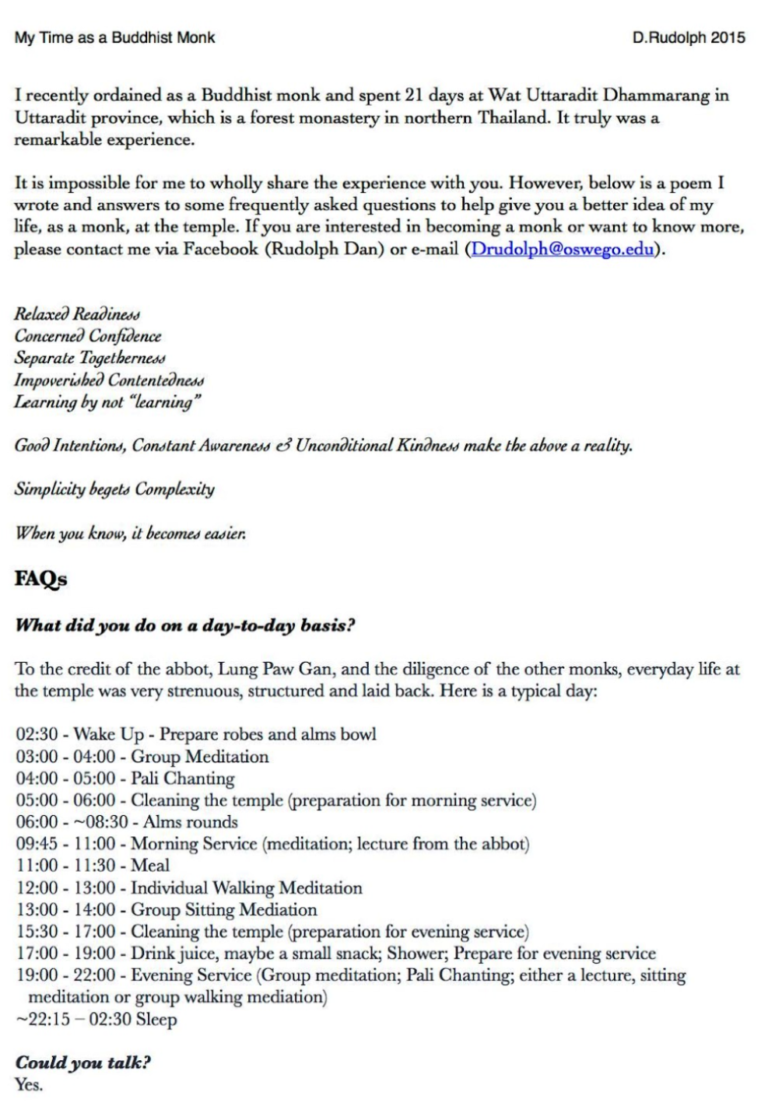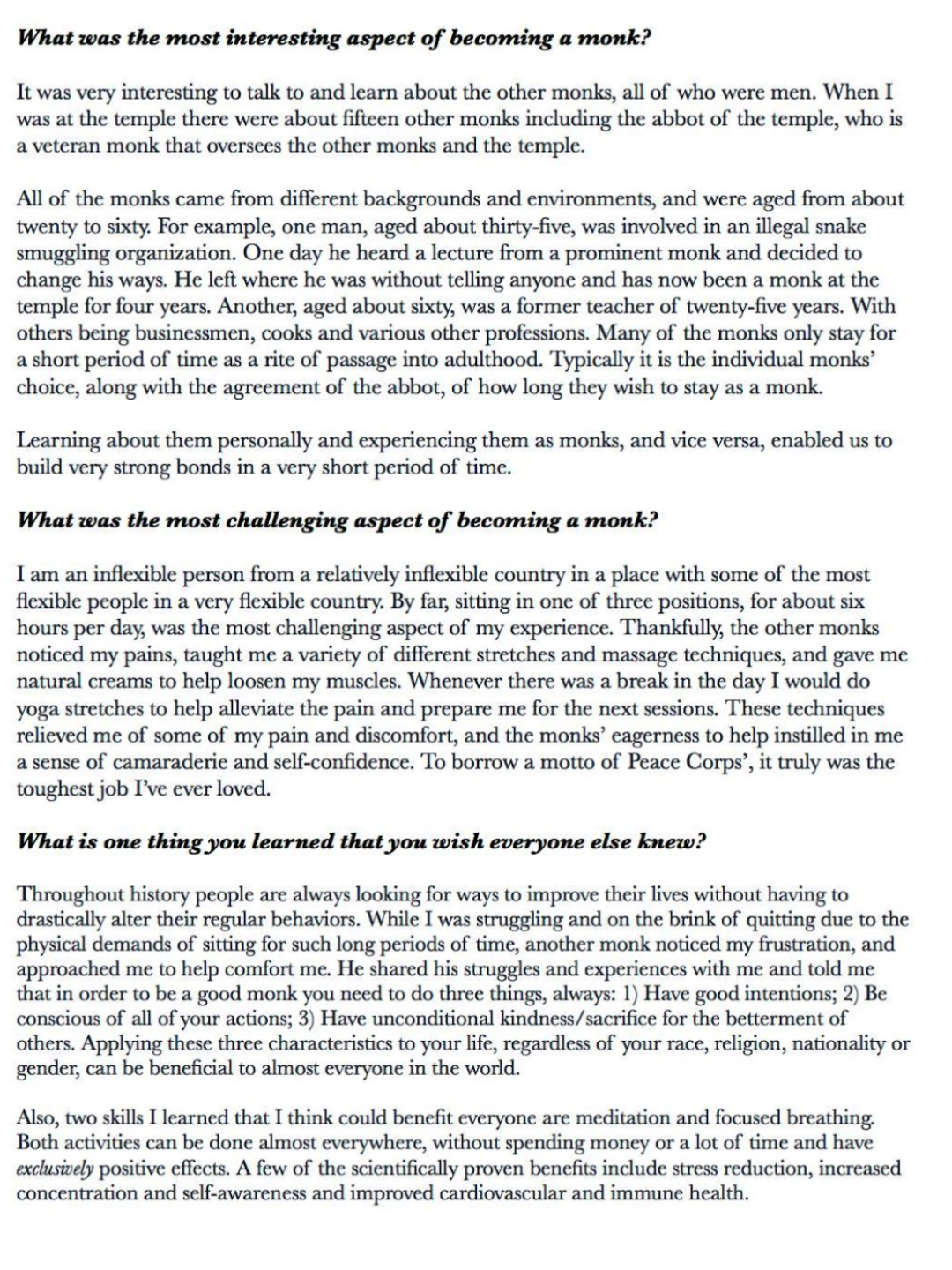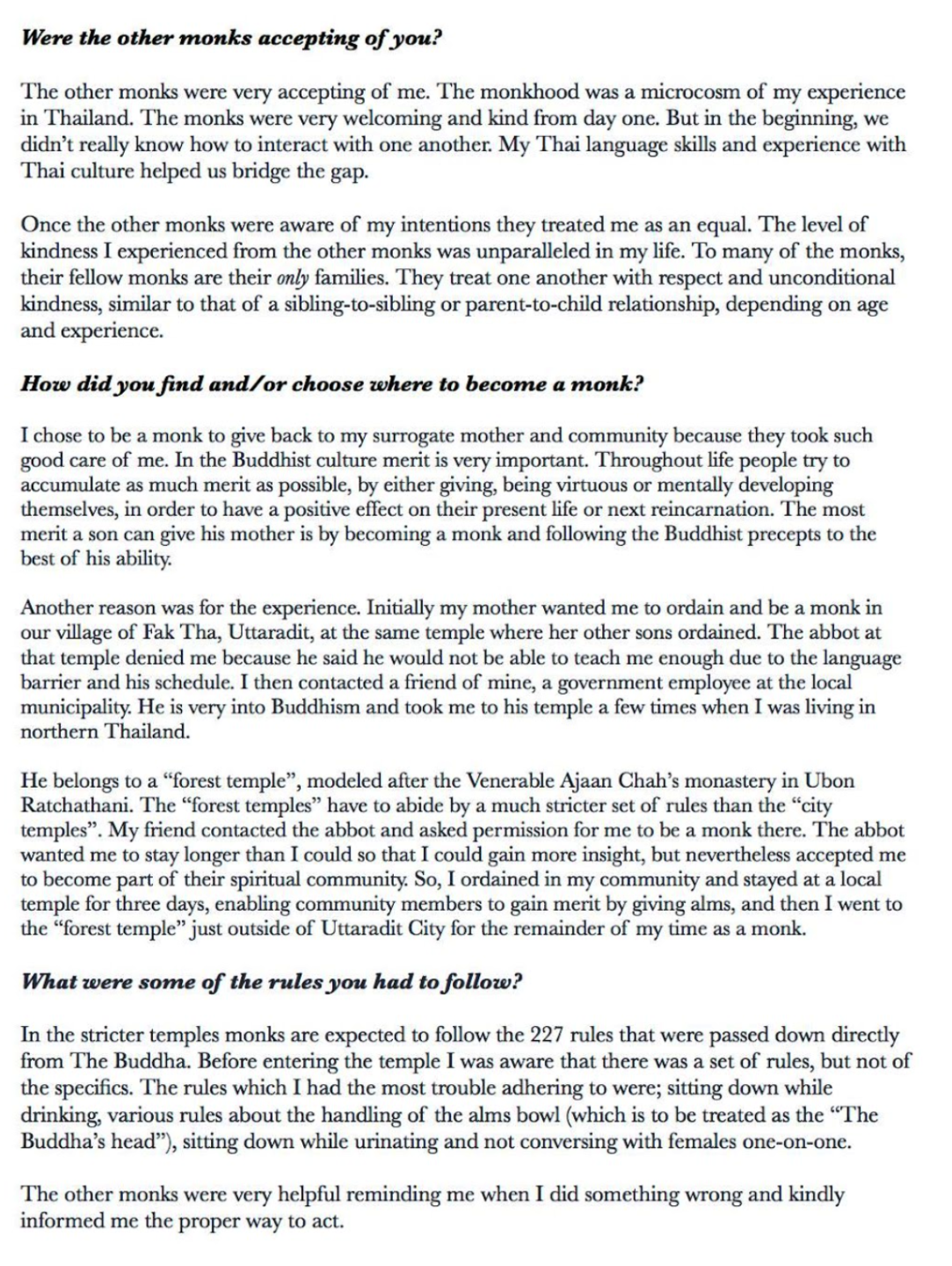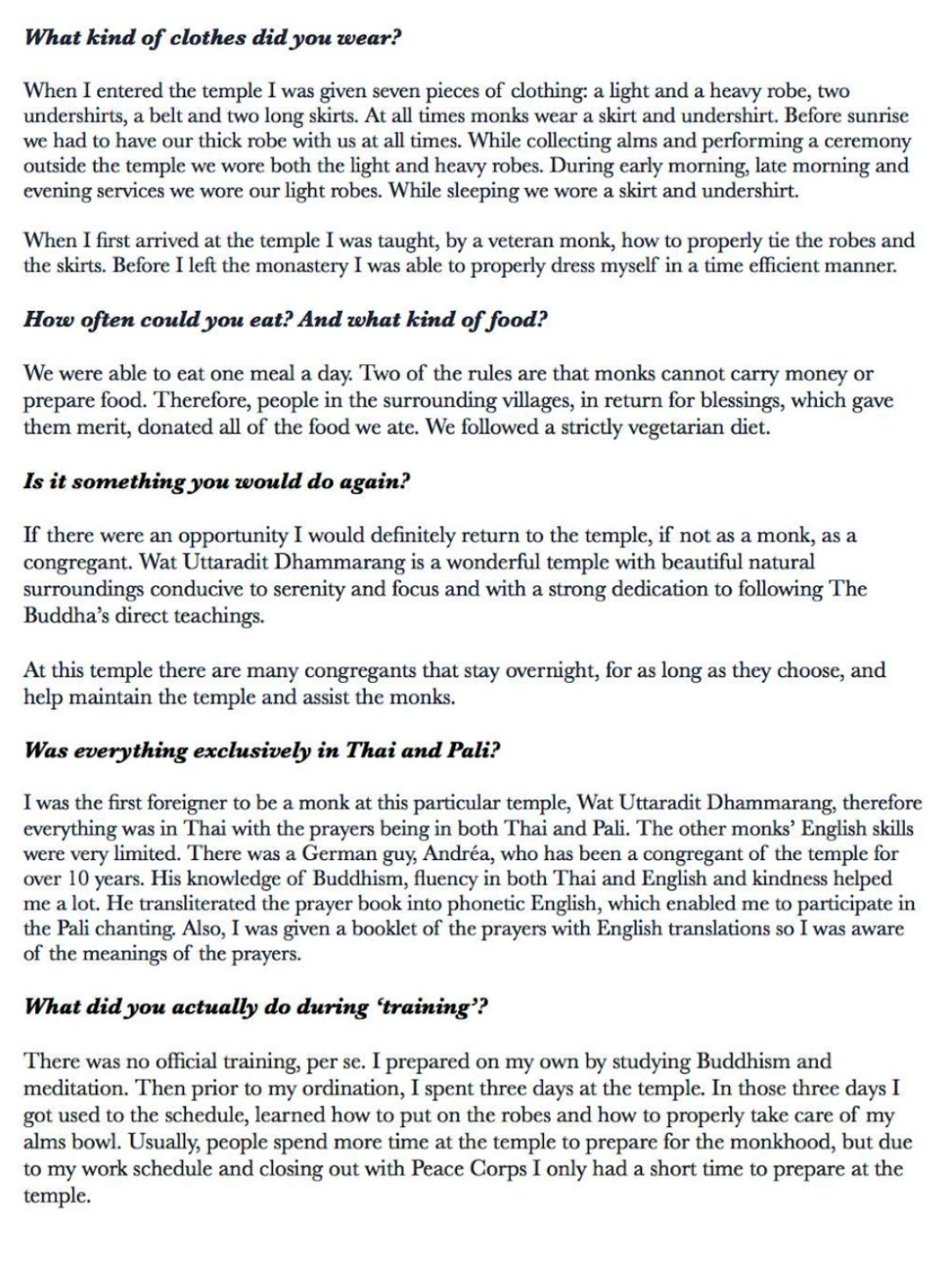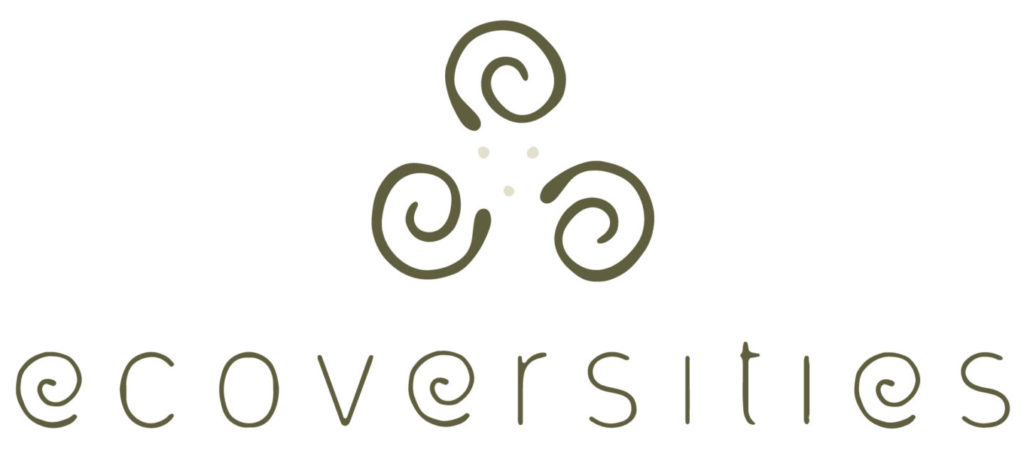By Daniel Rudolph
One of the most profound learning experiences of my life was while ordaining as a Buddhist monk, in a forest monastery in Thailand. My main intention for becoming a monk was to honor my host mother, and community, for the love they showed to me while living with them in their village for two years during my Peace Corps service. The action of becoming a monk is a common rite of passage in Thailand, where the sons enter the temple for a relatively extended period of time. It is seen as one of the biggest honors a son can give to his mother and community, as well as serving as a cultural symbol for the transition from childhood into adulthood. This ritual is becoming less common with young Thai adolescents.
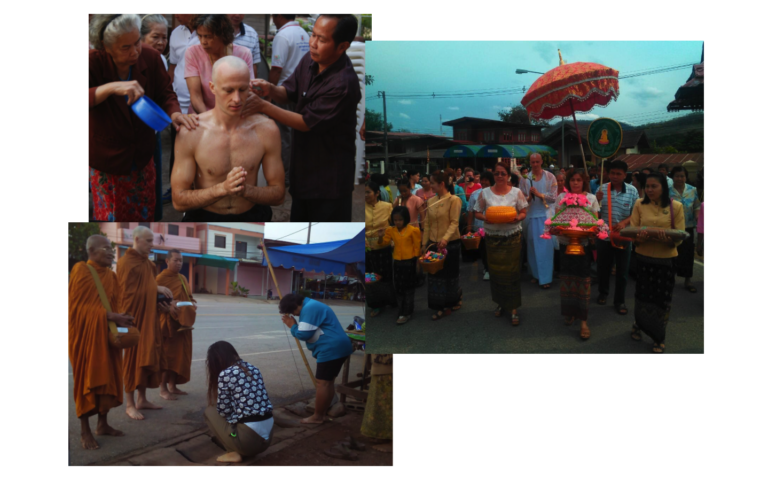
As with my experience during the Peace Corps, my experience as a monk in the temple was transformational and led me to receive many unexpected teachings. It led me to see the temple, not just as a place for spiritual refuge, but rather as a place of teaching and learning. It led me to realize the importance of thinking outside the box and expanding what we define as ‘education’ to include a multitude of spaces, people, and intelligences. It led to me to start seeing everywhere as a place of learning, and every being as my teacher.
When thinking of the monotony of learning that takes place within the box of most formal education institutions I recollected on my time in the temple, and the effective and liberatory pedagogical tools that were embodied within it. This recollection led me to dissect my learning from the temple, and develop it as a pedagogical tool that could be used in other spaces as a means of deep learning, practical skill development and liberation. What resulted from this reflection and dissection is the Pedagogy of the Temple.
I was the only non-Thai person at the monastery. Given my experience with the Peace Corps I had the language skills and cultural understanding to acclimate, especially since none of the other monks in the temple spoke English. Interestingly, as in the Thai village, many of the monks were interested in improving their English language skills and were curious to learn more about my experiences in America. Although my language skills were good (I tested out near fluent) and I had been immersed in Thai villages for over three years, there were many instances in the temple where I did not fully understand the content in the Dharma talks and conversations with the other monks and the teacher, Lung Paw Gan.
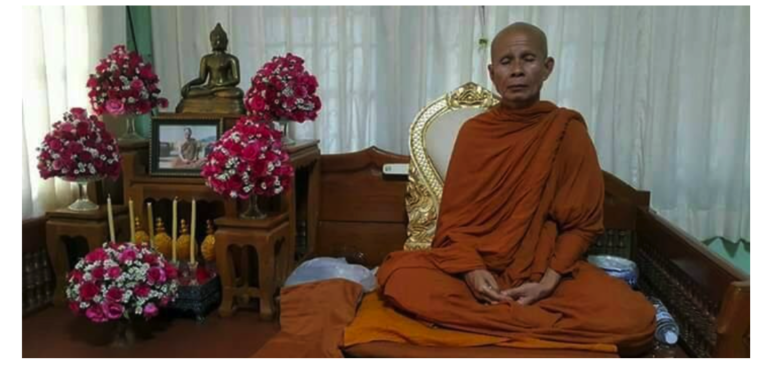
Given that the Pedagogy of the Temple is a liberatory pedagogy, it is inherently a decolonial pedagogy. It is a pedagogy that empowers people to come closer to their ‘authentic selves’ and to act with greater compassion and integrity. Given our current systems of extraction, disconnection and violence, the Pedagogy of the Temple, like a compassionate trickster, is inherently counter-cultural and for the betterment of all living beings.
Pedagogy of the Temple: PEACE and Liberation
The learning that I experienced while at the temple was deep and very effective. In less than a month I discovered skills, knowledge(s) and awareness that, six years later, I still regularly apply to my daily life. I had powerful individual and group experiences that both pushed me out of my comfort zone, and pulled me into my heart. These experiences drastically altered my perception, and subsequently my actions.
Although the temple that I was at was religious, and physically removed from the community, the Pedagogy of the Temple is a secular approach that can be applied in most any environment, with learners of all ages. The Pedagogy of the Temple is a teaching pedagogy that encourages teaching and learning, which is Practical, Experiential, Altruistic, Constructivist, Ecological, and Liberatory. It is also known as The Pedagogy of PEACE and Liberation.
The examples given in the sections below are based on my experiences becoming a monk in the temple, thus are related to Buddhism and Buddhist concepts and practices. If my experience of the Pedagogy of PEACE and Liberation were in a bakery, the characteristics would stay the same, but the examples would be related to healthy baking, customer service, and organic, local ingredients, instead of meditation and The Eightfold Path.
The Elements of PEACE and Liberation
In the sections below the six elements of the Pedagogy of the Temple are explained. Each element is defined and then reinforced with my experiences at the temple. All of these definitions are working definitions that I tailored for the sake of this article. All of these elements are inherently interconnected, and many times multiple were experienced simultaneously. For the sake of this article, and succinctly introducing the Pedagogy of the Temple, each element is described separately. Naturally, as I imagine you will notice, there is overlap within each section.
PEACE and Liberation: Practical
Practical learning refers to hands-on learning that has an applicable purpose in the learner’s life.
The majority of the learning that took place while I was in the temple was practical, both to life inside and outside of the temple. Meditation was a core practice that was taught at the temple. Each day we meditated for at least six hours, a mix of both sitting and walking. Prior to the temple, I had very limited experience meditating. Through hands-on practice, making mistakes, and guidance from my elders and peers I gradually improved my ability to meditate. Since my time in the monastery I have had intermittent practice and have led meditation groups and one-on-one sessions for people. These experiences also led me to join MAPLE Monastic Academy, where I am currently training and living. Meditation has enabled me to perpetually ground, and re-ground myself, and connect to various different individuals and communities.
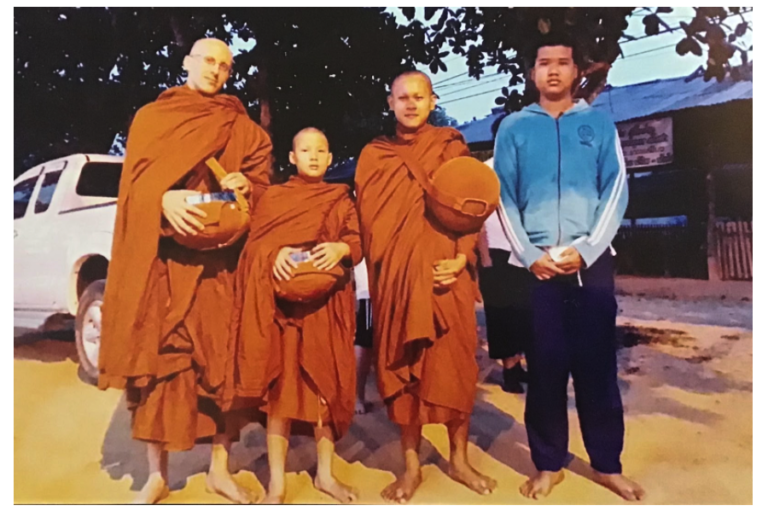
Meditation was not limited to formal sessions. I also learned techniques to regulate my breathing, and meditate anywhere, and while doing almost anything. An example of this was cleaning meditation. Every day we would clean the temple for two hours, one hour of sweeping outdoors, and one hour of cleaning inside and around the temple. While sweeping I was taught to align my breathing with my actions – inhaling with a forehand swipe, and exhaling with a backhand swipe – enabling me to regulate my breathing, and maintain presence while sweeping. Similarly, while learning how to mindfully mop a monk modeled and explained to me how to count the amount of tiles per swipe of the mop, and similar to sweeping, to align my breath with each swipe.
The same applied to eating. Just like sitting meditation and labeling the in-breath and out-breath with my inner voice, I was taught to mindfully eat by mentally saying each motion, lifting the fork, opening my mouth, chewing, chewing, chewing, swallowing, etc. Both of these skills I still use to this day, especially when I am in need of slowing, or deactivating, my brain and regaining presence. This mindful activity supports me in down-regulating my central nervous system and checking in. Still to this day I regularly practice mindful breathing before every meal (my parents lovingly joke and play a game trying to break my concentration before dinner) and mindful eating while consuming each meal.
During my professional experience I have worked in schools in five different countries: USA, Thailand, China, Germany and India. Although there have been many positive isolated examples of hands-on practical learning (i.e. students learning science, math and EVS in a school garden, children learning English through making food and writing recipes etc.) on a whole the learning that I have observed and experienced has not been practical. Rather, it has been designed based on the outcome of passing an exam. There was so much exam-based knowledge that I was forced to learn during my years of schooling that have not been of practical use to me at all in my adult life. From middle school onwards a large majority of my learning was in the non-practical category.
This aligns with the ‘Capability Crisis’ that the pioneering educationalist, Zak Stein, has identified in his extensive research into contemporary mainstream education institutions. To emphasise the urgency of these crises of capability Zak elucidates;
“ … the world’s problems are becoming more complex in the same historical moment when human capabilities are remaining simple, deficient, and fragmentary. An educational crisis is a crisis of capability; the only resolution is learning and transformation. Individually, we experience these quite often; when more is asked of us than we can give, the only resolution is to learn, to grow, and to develop new capabilities. But whole societies can go through similar crisis of learning and capacity development. Entire civilizations disappear because they are unable to learn what they need to survive. Ecological crises have always historically been accompanied by an educational crisis…”[1]
Since much of the learning that is happening in schools is not practical, it is also rarely experiential. There is a quote that an old friend, Michael Hamby, shared with me while we were traveling together in Thailand, “when you travel alone, you learn the most about yourself. When you travel with others, you learn the most about them.” Traveling is inherently experiential. As the quote alludes, traveling is a means for self-awareness and for the development of compassion and understanding. When traveling, as with most experiential learning journeys, weaknesses, and strengths alike, are brought to the surface. Experiential learning brings us closer to our truths, and the truths of the world.
PEACE and Liberation: Experiential
Experiential learning refers to learning that is sensorial, enabling the learner to feel and deeply experience what they are learning.
Impermanence (anitya), suffering (dukkha) and no-self (anatta) are considered the three characteristics of all phenomenal experiences, according to the Pali Canon, which is the seminal set of texts in Theravadan Buddhism [2].
During my time in the temple, I deeply experienced each of these concepts (anitya, dukkha, anatta). One practice that we would often do was walking meditation in a nearby rock garden. The garden was full of relatively sharp rocks. As with the majority of my time as a monk, this walking meditation was done without wearing shoes. At first, this was very painful for me. My mind became attached to the suffering from the sensorial pain that I felt in my feet, which caused me to forget about the impermanence of it.
After the first few times doing walking meditation in the rock garden, I realized that after we exited the garden, the pain stopped. My feet actually felt extremely relaxed and full of energy!
Through the repeated experience of walking in the rock garden, I began to experientially understand the concept of impermanence. Over time, while walking in the garden, I began to stop identifying with the sensations that my feet were feeling and started to truly be present to the experience. What at first was an experience of impermanence – the pain being there and then going away – developed into an experience of transcendence – the same act that used to be painful was now no longer painful. What used to feel like a long, miserable trip was now just a trip. The same now applies to long bus rides, train journeys, interpersonal interactions, etc.
Another experiential example of suffering and impermanence had to do with hunger and food. While at the temple we would eat only once a day, which was a major shift from my regular routine of three meals a day (plus snacks!). At times I would feel extreme hunger. Like with the sharp rocks, I would identify with this hunger, and it would take over my mind, disabling me from being in the ‘now’. There were many instances where I would feel a deep hunger, and then engage in another activity, such as chanting or cleaning, and after the activity, the hunger was gone. Over time, I was able to notice the onset of hunger, but not become attached to it. To just feel it for what it was, knowing that like the pain that I felt from the rocks, the hunger, too, would pass. This taught me frugality and voluntary simplicity.
The same was experienced with the opposite. Music was not allowed in the temple, as strict Buddhist doctrine sees it as a means of distraction and disconnection. Being a self-identified lover of music, this led me to observe deeper connections with the patterns and movements that occurred around me. It led me to feel the music in everything (trees, breath, sound of the sweeping broom, crunching of the leaves).
One day, when we were in the middle of our individual walking meditation practice I was deeply present while mindfully pacing back and forth in a sand-pit. All of the sudden, a prayer with instruments (the closest thing to music that I heard in over three weeks!) came on the loudspeakers. It shook me to my core. I stopped in my tracks and just absorbed the sounds. They vibrated throughout my being. After soaking in the music, for what seemed like an eternity, I opened my eyes and tears were pouring down my face. I was in complete presence, and at complete peace. The silence enabled me to hear (and feel) again.
Through schooling and life many people are encouraged, and in many circumstances, forced to be busy all the time. They are forced to perpetually ‘hustle’ to survive and stay busy out of the presumed fear that if they do not hustle they will not have enough. In many cases this is the reality, in some, it is a perceived reality, which is based on scarcity. When we slow down, take a step back and look around, we notice the abundance. This deep experience has the potential to remind us what really matters, and naturally want to live more ecologically, so we can be connected with what really matters for increased periods of time.
This way of being perpetually busy is a learned behavior. Some would argue it could be considered an addiction. Gabor Mate defines addiction as “any behavior that a person finds temporary pleasure or relief in and therefore craves, suffers negative consequences from, and has trouble giving up.”[3] In many instances schooling creates this addiction, and then finding a job, to earn money and support one’s self and their families, perpetuates it. What can we do to cure this addiction? The scholar Bayo Akomolafe advises that, the times are urgent, and we must slow down.[4]
As James Baldwin emphasises in the documentary “I Am Not Your Negro” we, as individuals and collective communities, must acknowledge our weaknesses, before we can struggle and transform them [5]. For many this might mean inviting conflict and bringing to surface uncomfortable truths. This is hard work.
As I was supported by elders, and counseled during my transition into the monastery, we must do the same for each other as they go through transformational transitions. I experienced true selflessness in the community in the temple.
PEACE and Liberation: Altruistic
Altruistic learning is learning that is not focused on self-interest, but rather for the betterment of the surrounding living systems, both human and non-human.
While in the temple I truly learned what unconditional love, and brotherhood, were. Everything that was needed (food, shelter, clothing etc.) was provided by the temple. Nobody needed anything. Therefore, nobody wanted anything from anybody else. This enabled selfless action, genuine care for one another, and a sense of deep community.
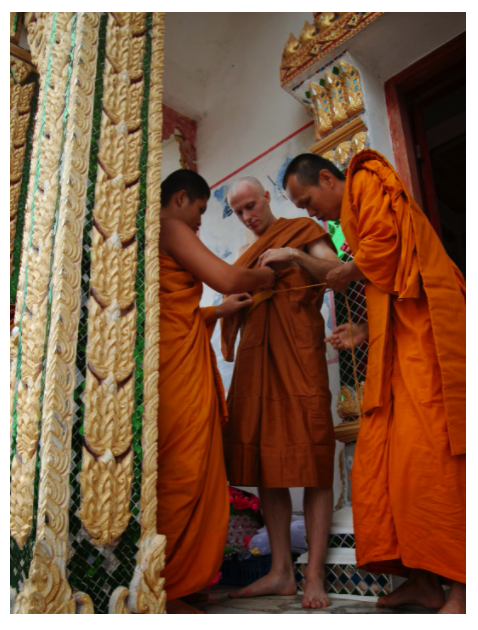
There were times when, as a result of the extended periods of sitting, I felt extreme joint and body pain, which made it extremely difficult to move. The other monks noticed this and, without solicitation, went out of their way to teach me stretches, give massages and offer other strategies for preventing and dealing with the discomfort. They did this as if my pain was theirs.
This selfless altruism extended beyond the temple walls, and into the nearby community as well. In the relatively short period of time that I was there we went into the community and did a trash-pick up surrounding a nearby body of water, we planted trees and on Songkran (the Thai New Year, also known as the ‘water festival) we donated fish to help populate a nearby pond.
Similarly, we were taught to be altruistic to ourselves. To listen to our egos, and notice the inherent self-interest, but not to negatively judge ourselves because of it. Just by gently listening I was able to acknowledge many things that were holding me back and causing me to perpetuate harmful actions. Instead of ignoring, or self-deprecating, I was able just to sit with them, and realize the pain they were causing me and other living beings. This has since led me to act with increased awareness. I am now able to embrace my flaws, and consciously feel the negative repercussions of them, which has eventually guided me to lessen harmful behavior and pursue more regenerative behaviors.
In school growing up, most of the learning that was organized was individualistic and separating. Written tests were the main form of assessment for students in most cases. Teachers were assessed based on the scores of the individual students in their classes. Given the desired outcome, learning was designed in an individualistic manner. This experience was inherently competitive. Cooperative behavior on such exams was considered cheating, and punished.
While working in schools in China, students’ scores were publicly posted. From a young age children were labeled as being ‘smart’ or ‘dumb’ based on these scores. While working in rural Thailand and India it was almost a hindrance to be a ‘smart’ student. The ‘dumb’ students were allowed great freedom. In many cases they were allowed to play with their friends during lessons, or simply not come to class and they were not expected to do assignments, regardless how much the teachers pretended to care. All the while, the ‘dumb’ students were often publicly shamed, while the ‘smart’ students were celebrated.
In a large majority of the mainstream school settings that I have been a part of, the multiple intelligences of the students were not sufficiently honored. Emphasis was given to those that learn best through writing and reading. Genuinely smart learners, that have different intelligences, were often labeled as being ‘dumb’. Identity informs perception, and perception informs action.
While at the temple I was accepted as being perfectly imperfect with great potential. I was greeted with complete acceptance. My skills, experiences and intelligences were honored. I was given support and guidance to improve upon weaknesses. Within the group, I was given the tools to truly individualize my learning, and subsequently become a self-designed learner.
PEACE and Liberation: Constructivist
Constructivist learning refers to learning where each individual learner is looked at as being unique, and thus they are able to construct meaning based on their individual experiences.
At the beginning life in the temple was very challenging for me – adapting to the eating/sleep schedule, remembering how to tie my robes, caring for my alms bowl, conditioning my body to sit cross-legged for six hours a day etc. There were times that I did not think I could withstand.
When I was at one of my lowest points, which was late into the first week, a fellow monk noticed my despair and gently pulled me aside. He reassured me that each one of us are at a unique stage of development, therefore our abilities and experiences are unique. He commended me on my efforts and explained to me that it did not matter the outcome or quality of what I did, as long as I did it with 1) good intentions 2) loving kindness and 3) selflessness. This piece of wisdom guided me through the rest of my time in the temple, and has guided me since.
Instead of thinking of myself as broken, or comparing myself to others, I was able to accept my predicament, and thus work with the situation as per the ‘Work’ that I needed to do on myself.
Although we united as a community, each one of us were on our own individual learning journeys, that we naturally were able to tailor based on our understanding and capability. Everybody was welcomed. There were people that society labeled outcasts that found meaning and purpose in the temple – one guy had previously been involved in an illegal snake smuggling operation, one guy had been an alcoholic and had problems with his family. There were many adolescents that were there for short periods of time as a rite of passage into adulthood. There were some monks that had been in the monkhood for over twenty years, and the abbot for over forty!

During my schooling all of the students in my grade were expected to learn the exact same content at the exact same pace. There was very little individualization of content. My good friend throughout school was labeled a terrible student. He was at least two levels behind in most subjects. Kids would tease him for these difficulties in school. After school, I would spend a lot of time with him in the workshop in the basement of his mother’s house. There he would disassemble and reassemble small gas powered vehicles. He knew the functions of all the parts of the cars, and how to repair them. In his basement he was a great student, he was, as the schools label, ‘talented and gifted’. In my schooling experience I have experienced many of these types of learners that simply did not fit in with the homogenous expectations of formal schooling and, in many cases, suffered as a result of it.
At the temple each learner was honored and instructed based on their unique needs. Many of the practices that we did were similar, but each one of us had very unique experiences, and were able to receive exactly what we needed.
Ajahn Chah, the notable forest monk and teacher described this. He said, “It is as though I see people walking down a road I know well. To them the way may be unclear. I look up and see someone about to fall into a ditch on the right-hand side of the road, so I call out to him, ‘Go left, go left.’ Similarly, if I see another person about to fall into a ditch on the left, I call out, ‘Go right, go right!’”
Similar to Ajahn Chah’s description, through compassionate conversation and observation, Lung Paw Gan (the abbot) would give direct instruction and invite specific people to take on specific tasks based on their individual needs. These included, fasting from food, sleep, and speaking, cleaning certain areas of the temple, going on solo expeditions into the forest, etc.
Although each of our learning journeys looked different we were all working towards a similar goal: elimination of suffering. This path encouraged us to be present more, to do activities that enabled us to create (not waste) our energy, and to consume less. The skills I learned in the temple taught me to preserve and use my energy wisely, which, naturally has made me live more ecologically (consuming less, maintaining my health, reflecting more and enabling other people space to reflect, etc.). My time in the temple taught me the valuable lesson that when we learn to use our individual energy more wisely, naturally we require less natural resources, thus we act in a way that requires less external energy from Gaia.
PEACE and Liberation: Ecological
Ecological learning refers to learning that is regenerative, or has a net-positive impact on the living environment.
Often, the interventions that are the most sustainable for the environment, are the ones that indirectly address the core problems. Solutions that get to the roots, and address the generator functions [6] that are plaguing individuals, communities, countries and the planet. The temple was focused on developing tools and practices for attaining enlightenment, within the Theravaden Buddhist tradition. However, it encouraged and perpetuated ecologically regenerative behavior.
Temples are spaces of spiritual practice. There are many interconnections between the spiritual and the ecological, and many scholars, including myself would argue that they are the same. For more information around the relationship between the spiritual and the ecological, here are a few examples: Capra, Macy, Scharmer, Forall, Jain, Bateson, Hine & Kingsnorth, Shaw, Akomolafe, Giangrande.
The culture of the temple, and of monkhood, was naturally regenerative. We ate a strictly vegetarian diet, which was provided by people in the community on our alms rounds each morning. We consumed less. Each person was allotted seven pieces of clothing, which were worn during all seasons of the year. We were not allowed to carry money, thus we did not contribute to the negative environmental impacts of global consumerism. Since we consumed less we required less resources.
Through the congregants that came to the temple, we encouraged the same, and gave people in the community a space to come and develop tools that they could use in their homes and communities, which might enable them to live more ‘sustainably’. In addition, beyond the people that came to the temple, we went into the nearby community and did outreach projects a couple of times in the month that I was there. As mentioned before, this included planting trees, cleaning trash, and restoring and developing non-human natural ecosystems.
On a personal level, all of our actions and practices were regenerative. We meditated and held space for other people to come and meditate. We were in the forest, surrounded by a great diversity of trees, which has also been proven to have beneficial health effects. And, we cleaned, and sometimes did relatively heavy work, which enabled us to physically stay healthy.
There was an alternative narrative, and set of values in the temple, that countered the contemporary capitalist values of consumerism, which largely operate based on extraction, self-interest and exploitation. In the temple, we lived by community, cooperation and regeneration.
While growing up I remember the snack bar at lunch. We were served junk food that was very high in sugar. The school lunches were made of processed ingredients and were objectively unhealthy.
The bulk of the information we were consuming while in school was not supporting us in sense-making and or living more sustainably in the world. For me, and many of my peers, the most valuable learning happened outside of the classroom, in the informal spaces of gathering and interacting, such as the playground, lunchroom, gym class, sports teams etc. The relationships that I developed in these informal spaces at school have ‘lasted me a lifetime’ and have taught me a lot about myself and the world.
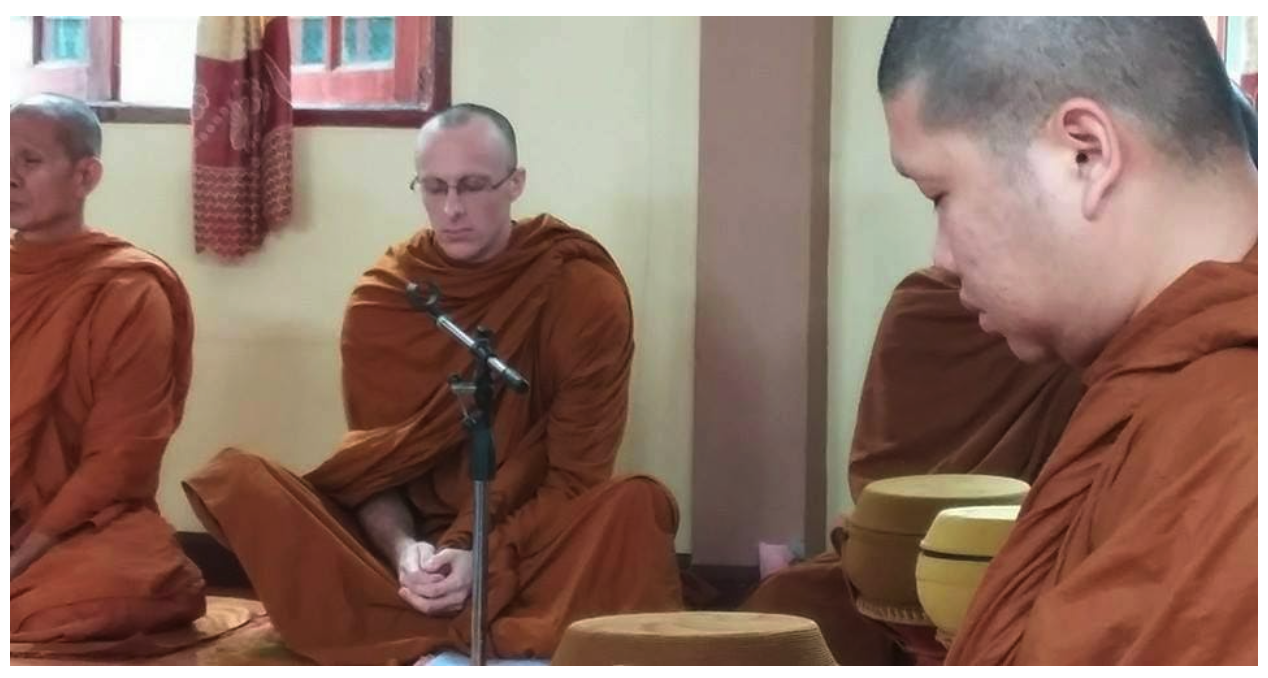
Paradoxically, most of my learning that happened inside the classroom has vanished. It was not until I left America, and was living in Thailand, that I realized how naive and ignorant I was. This is when I started to ‘wake up’. This is when I began to be curious and to seek out learning opportunities. This is when I realized that the world is the true curriculum, and the work is in learning how to most effectively ‘be’ in the world. This understanding that has developed has supported me in living with a sense of purpose, with the intention of embracing each of my actions and interactions as experiences for learning. This has supported me in developing the confidence to act based on truth, as opposed to societal expectations. My time at the temple supported me and gave me tools, and perspective, to do this more effectively. This is the path embodiment, connectedness and resilience. School taught me to be disembodied, disconnected and dependent.
PEACE and Liberation: Liberatory
Liberatory learning refers to learning that encourages learners to develop self-awareness in order to free themselves from oppression – i.e. addiction, desire, attachment.
Through the practice of meditation each of us were able to slow down, and spend time with ourselves. For me, this led to a deeper self-awareness, where I realized my ‘attachments’, or things that I desired, and how they were controlling my actions. In the words of Gurjieff, I accepted the fact that I was in a sort of self-imposed prison [8]. This acknowledgement enabled me to work with these desires. The process was (and still is) liberating as it gave me a chance, as well as tools, to work with the things that were holding me down.
We were taught practices for acknowledging and working with these ‘chains’ that were holding us down, as opposed to ignoring, accepting and/or beating ourselves up about them. This process still is liberating for me, and I often catch myself falling into a pattern of thought or action, and just noticing it (as we did while meditating) and mindfully feeling the negative effects of it.
It is interesting, as each time I come back to my hometown, after being away for long periods of time, I dance with my past attachments (i.e. alcohol, junk food, porn etc.) and over time I am finding myself either stopping these actions that previously controlled me, or consciously, and more moderately, doing them. This has (and still is) leading to increased personal freedom, autonomy and self-awareness and decreased guilt, self-hate and judgement. Gradually, I feel myself becoming more connected to myself and my environment, gradually, I feel myself moving forward. Stephen Jenkinson, in a Zoom Teaching [9] I attended in mid-December, responded to one of my questions, “What role (if any) does resistance play in the process of dismembering?”, by inviting me to try and resist the resistance, and eventually transcend the resistance into remembering.
When comparing the temple, to the school, as a place of learning, the temple gave me tools and perspective that were liberatory, while the school gave me strategical tools for survival in an inhumane environment, which were inherently not-liberatory.
Subsequently, after being in the temple, I now had increased perspective and capability, and could externalize the learning and more effectively work to enable others to decrease their suffering and to enable the groups that society deems ‘voiceless’ a chance to spread their voice. This includes the non-human living environment (i.e. trees, mountains, oceans, animals).
Back to School
Ivan Illich, in his pioneering 1971 book, Deschooling Society, writes “Once it [the institution] reaches a certain threshold, the process of institutionalization becomes counterproductive.” [10] With the school in mind, this means that the actions of the school are perpetuating the opposite of the values that they purport. As an experienced practitioner, having worked in schools in five different countries, it is becoming clear that the institution of school, in many instances, is actually causing more harm than good. The way schools are structured oftentimes does not make physiological or psychological sense with regard to the development of the learners.
The reactionary measures of putting all of learning online is a prime example of this. Children, as young as five years old, in many places are expected to sit and learn in front of a computer for over five hours a day. This does not make sense, and based on the research on neuroscience and technology, can cause great harm to the child. The pandemic has exposed many of the flaws of our modern education systems. These flaws were there before, but they were kept behind the closed doors of the school, and perpetuated based on a delegitimized system of hierarchy where the individual students voice is often silenced by the teachers. Where speaking and acting truth is considered acting out, and is punished.
This is a difficult situation for teachers as well that are expected to impose these ways of being. The documentary series ‘Immigration Nation’ [11] vividly chronicles the job that the officers from the Immigrations and Customs Enforcement (ICE) agency have to do in the United States of America. There was one point in the, Trump administration, where undocumented immigrants, that were trying to cross the border, were detained and separated from their children. After three months, due to public resistance and pressure, the policy was overturned and the detained parents were reunited with their children. During the interviews the ICE officials expressed that they were ‘just doing their jobs’ and that part of their job was to feel no moral obligation for the people they were detaining.
This was emphasised by an example, where Henry Giroux was referenced, that Paolo Friere and Donaldo Macede gave in their book Literacy: Reading the Word and the World [12]. I summarized the example that Friere and Macedo gave, on page 26 of their book, in an example in another, currently unpublished, article that I wrote,
“… Henry Giroux emphasized this polarization that teachers face through explaining the findings of a study done with teachers from Boston, he explained that “ they [the teachers] were asked to teach kids to take risks, weigh alternatives, and exercise independent judgement while being restricted to teaching practices that emphasized the rote, mechanical, and technical aspects of learning and evaluation.” As he exemplified with the case of teachers in Boston, I have observed, and deeply felt this conflict, with the different teachers and schools I have worked with in: inner city New York, rural Thailand, Beijing, rural India and different cities in Germany. From my experiences … it is generally not that teachers do not want to nurture, rather due to the constraints that are inherent in the system, they are often circumstantially forced to do so.”
This is similar to the experience that many middle and upper class parents, operating in contemporary mainstream institutions, face when having to stick up for the teachers that are working in these seeming;y ‘counterproductive’ schools and forcefully encourage their children to go to blindly obey and attend, and, in many cases, continue on to formal institutions of higher education even if they, they child, do not want to.
Parents, as the teachers working in formal schooling institutions, are put in a position where they have to do and enforce things that they intuitively understand do not make sense, based on the design of the system. Many students, the real clever ones, speak out against this and rightly challenge the teachers. Based on job security, the teachers have to speak ‘half-truths’. Zak Stein labels this as the ‘Legitizimation Crisis’ [12]. In a talk that Martin Shaw gave, as a part of the 2020 Climate Sessions organized by A School Called Home [13], he urged that at this point in the narrative, we are not in times of the Hero, rather we are in the times of the Trickster. We need to think outside of the box and find alternative solutions outside of the mainstream, all the while, with complete compassion for the mainstream. In a private conversation with Zak Stein, he framed this as building a bridge between the ‘best of the best’ (the best examples within the mainstream) with the ‘first of what’s next’ (the pioneers that are doing work with alternatives).
Contrasting to the Pedagogy of PEACE and Liberation, school often breeds HATE and Limits Freedom. Due to the competitive nature, which has amplified in recent decades with the increased emphasis on standardized tests, school has become more competitive, leading to increased emphasis on competitive behavior, self-interested action and labelling. Kids that have intelligences that are not aligned with the prescribed ‘bookish’ curriculum and tests, are often labelled dumb, and learn from a young age that they are not special. Similarly, over achievers get sucked into the competition, and the stress it causes. This has led to increased early onset of anxiety, depression and suicide in adolescents. This self-hate and competition splinter from the school yard into the rest of the world, encouraging over-consumption as a means of distraction, and mistrust as a means of protecting us from them.
When I was in school I did not learn very many practical life skills. Paradoxically, to get by in school I learned how to cheat and work around the system. The learning I experienced was often not practical, experiential or relevant. I recall regularly asking, “Why are we learning this?” to get the same response “… because you have to” or “… because it is on the test”. By the end of high school I lacked self-awareness and direction, and although I was not mature enough, rushed into university, because that’s what was expected of me.
Back to Reality
Education is all around us. Within our communities – the mechanics, refugees, elders, electricians, artists, etc. Education is an ongoing process, from the day we are born until the day we die. For each one of us it is unique, and infinitely meaningful. Our bodies are our temples, as are our parks, communities and wider ecosystem(s). The Pedagogy of PEACE and Liberation is a tool to bring us back to reality. To acknowledge our shortcomings, and the systemic illusion(s) that guide our everyday lives. It is a pedagogical tool that urges us to slow down and come together in a healthy, regenerative, way. It is a tool to free us, and the human and non-human beings around us.
The time is now. It is my hope that the Pedagogy of PEACE and Liberation be widely spread and compassionately applied to all spaces of learning with the non-outcome based intention of lessening the suffering in the world, and increasing connection, and harmony, between the various relationships that an individual experiences: self-self, self-other, self-non-human-other.
Daniel Rudolph
For the past ten years my work experience and professional development has been focused on education. I have worked with students and teachers in inner-city New York, rural Thailand, highly urbanized China, rural India, Germany and now rural Vermont.
Through working in these diverse environments I have been exposed to various educational philosophies and pedagogic practices. There have been recurring similarities and differences between students, teachers, schools and school systems. These observations have led me to question the mainstream way of doing things and explore alternative methods towards educating our youth and ourselves.
These inquiries have led me to MAPLE Monastic Academy, where I am currently a resident. Through intense monastic practice and living/working within community I am learning how to live and lead with more compassion. Ultimately, my goal is to become a better teacher and learner.
It is my vision to merge these experiences in education, mindfulness and community living and apply them to opening a community learning space. If you are interested in collaborating, learning more about my vision or sharing experiences feel free to connect.
1 Below is a document I prepared after ordination when there was a lot of curiosity from family and friends
